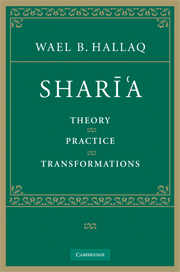Book contents
- Frontmatter
- Contents
- Preface and acknowledgments
- Introduction
- Part I The pre-modern tradition
- Part II The law: an outline
- 6 The legal pillars of religion
- 7 Contracts and other obligations
- 8 Family law and succession
- 9 Property and ownership
- 10 Offenses
- 11 Jihād
- 12 Courts of justice, suits and evidence
- Part III The sweep of modernity
- Appendix A Contents of substantive legal works
- Appendix B Chronology
- Bibliography
- Index
8 - Family law and succession
Published online by Cambridge University Press: 05 June 2012
- Frontmatter
- Contents
- Preface and acknowledgments
- Introduction
- Part I The pre-modern tradition
- Part II The law: an outline
- 6 The legal pillars of religion
- 7 Contracts and other obligations
- 8 Family law and succession
- 9 Property and ownership
- 10 Offenses
- 11 Jihād
- 12 Courts of justice, suits and evidence
- Part III The sweep of modernity
- Appendix A Contents of substantive legal works
- Appendix B Chronology
- Bibliography
- Index
Summary
Marriage
A sanctified social and legal institution, marriage (nikāḥ) was seen in Islam as the cornerstone of social order and communal harmony, for as an institution it simultaneously regulated sexual, moral and familial relationships. In quasi-legal literature, its goals were said to have been preservation of pedigree and sexual fulfillment for both men and women. Since the only conceivable way of bringing children into this world and of raising them properly was through marriage, and since sexuality was equally inconceivable outside a lawful framework (which included lawful concubinage), the marriage institution thus became key to maintaining social harmony, the cornerstone of the entire Islamic order. Yet, in strictly legal terms, marriage as nikāḥ was a contract with a narrow scope, one that did not pretend to regulate the entirety of relationships that normally existed within marital life. Reduced to its essential contractual components – which make up the entirety of juristic formal discourse – the nikāḥ contract excluded what we might call the elements of companionate marriage (as widely defined), and limited itself to regulating, in strictly contractual ways, only those aspects of the matrimonial institution that pertained to the lease of services.
Together with habitual infractions of the law and illicit violence, sexuality outside marriage (zinā) is regarded as the primary cause of social discord, to be avoided at virtually any cost.
- Type
- Chapter
- Information
- Sharī'aTheory, Practice, Transformations, pp. 271 - 295Publisher: Cambridge University PressPrint publication year: 2009
- 1
- Cited by

